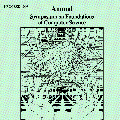$ \renewcommand{\tilde}{\widetilde} $We present an $\tilde{O}(\log^2 n)$ round deterministic distributed algorithm for the maximal independent set problem. By known reductions, this round complexity extends also to maximal matching, $\Delta+1$ vertex coloring, and $2\Delta-1$ edge coloring. These four problems are among the most central problems in distributed graph algorithms and have been studied extensively for the past four decades. This improved round complexity comes closer to the $\tilde{\Omega}(\log n)$ lower bound of maximal independent set and maximal matching [Balliu et al. FOCS '19]. The previous best known deterministic complexity for all of these problems was $\Theta(\log^3 n)$. Via the shattering technique, the improvement permeates also to the corresponding randomized complexities, e.g., the new randomized complexity of $\Delta+1$ vertex coloring is now $\tilde{O}(\log^2\log n)$ rounds. Our approach is a novel combination of the previously known two methods for developing deterministic algorithms for these problems, namely global derandomization via network decomposition (see e.g., [Rozhon, Ghaffari STOC'20; Ghaffari, Grunau, Rozhon SODA'21; Ghaffari et al. SODA'23]) and local rounding of fractional solutions (see e.g., [Fischer DISC'17; Harris FOCS'19; Fischer, Ghaffari, Kuhn FOCS'17; Ghaffari, Kuhn FOCS'21; Faour et al. SODA'23]). We consider a relaxation of the classic network decomposition concept, where instead of requiring the clusters in the same block to be non-adjacent, we allow each node to have a small number of neighboring clusters. We also show a deterministic algorithm that computes this relaxed decomposition faster than standard decompositions. We then use this relaxed decomposition to significantly improve the integrality of certain fractional solutions, before handing them to the local rounding procedure that now has to do fewer rounding steps.
翻译:我们提出了一种 $\tilde{O}(\log^2 n)$ 轮的确定性分布式算法,用于解决最大独立集问题。通过已知的约简,此轮复杂性也扩展到了最大匹配、$\Delta+1$ 顶点着色和 $2\Delta-1$ 边着色。这四个问题是分布式图算法中最重要的问题之一,已经研究了四十年。这种改进的轮复杂性更接近于最大独立集和最大匹配的 $\tilde{\Omega}(\log n)$ 下界[Balliu 等人 FOCS '19]。这些问题的先前已知最佳确定性复杂性为 $\Theta(\log^3 n)$。通过破碎技术,这种改进也影响了相应的随机化复杂性,例如,$\Delta+1$ 顶点着色的新随机复杂性现在是 $\tilde{O}(\log^2\log n)$ 轮。我们的方法是之前已知的两种方法之间的一种新组合,用于开发这些问题的确定性算法,即通过网络分解进行全局去随机化(参见例如[Rozhon、Ghaffari STOC'20;Ghaffari、Grunau、Rozhon SODA'21;Ghaffari等人 SODA'23]),以及对分数解进行局部舍入(例如[Fischer DISC'17;Harris FOCS'19;Fischer、Ghaffari、Kuhn FOCS'17;Ghaffari、Kuhn FOCS'21;Faour等人 SODA'23])。我们考虑了经典网络分解概念的一种放松,其中,我们允许同一块中的簇相邻,但要求每个节点有少量相邻簇。我们还展示了一种确定性算法,以更快的速度计算这种放松分解。然后,我们使用这种放松分解来显着提高某些分数解的整合性,然后将其交给局部舍入过程,该过程现在要执行更少的舍入步骤。



